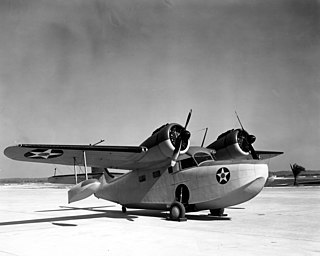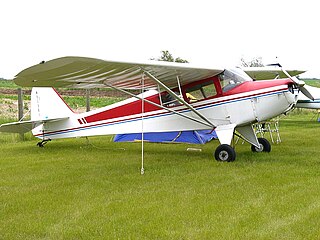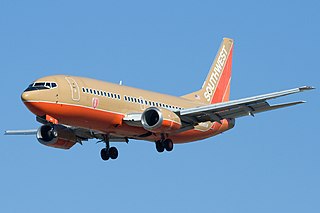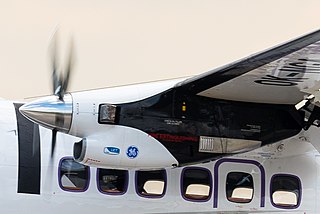
The Cessna 172 Skyhawk is an American four-seat, single-engine, high wing, fixed-wing aircraft made by the Cessna Aircraft Company. First flown in 1955, more 172s have been built than any other aircraft. It was developed from the 1948 Cessna 170, using tricycle undercarriage, rather than a tail-dragger configuration.

A liaison aircraft is a small, usually unarmed aircraft primarily used by military forces for artillery observation or transporting commanders and messages. The concept developed before World War II and included also battlefield reconnaissance, air ambulance, column control, light cargo delivery and similar duties. Able to operate from small, unimproved fields under primitive conditions, with STOL capabilities, most liaison aircraft were developed from, or were later used as general aviation aircraft. Both fixed-wing aircraft and helicopters can perform liaison duties.

The ERCO Ercoupe is an American low-wing monoplane aircraft that was first flown in 1937. It was originally manufactured by the Engineering and Research Corporation (ERCO) shortly before World War II; several other manufacturers continued its production after the war. The final model, the Mooney M-10, first flew in 1968 and the last model year was 1970. It was designed to be the safest fixed-wing aircraft that aerospace engineering could provide at the time and the type continues to enjoy a faithful following.

The Grumman G-21 Goose is an amphibious flying boat designed by Grumman to serve as an eight-seat "commuter" aircraft for businessmen in the Long Island area. The Goose was Grumman's first monoplane to fly, its first twin-engined aircraft, and its first aircraft to enter commercial airline service. During World War II, the Goose became an effective transport for the US military, as well as serving with many other air forces. During hostilities, the Goose took on an increasing number of combat and training roles.

The IMCO CallAir A-9 is a small agricultural aircraft that first flew in 1962, a development of the company's previous successful crop-dusters. It is typical of aircraft of its type - a single-seat aircraft with a low wing incorporating spraying gear.
The Intermountain Manufacturing Company (IMCO) was a US aircraft manufacturer of the 1960s based in Afton, Wyoming that produced agricultural aircraft.

Boeing Commercial Airplanes (BCA) is a division of the Boeing Company. It designs, assembles, markets, and sells jet airliners and business jets, and also provides product-related maintenance and training to customers worldwide. BCA operates out of its division headquarters in Renton, Washington, and has more than a dozen engineering, manufacturing, and assembly facilities located throughout the U.S. and internationally. It includes the assets of the Douglas Aircraft division of the former McDonnell Douglas Corporation, which merged with Boeing in 1997. As of the beginning of 2020, BCA employed almost 65,000 people.

The Continental C90 and O-200 are a family of air-cooled, horizontally opposed, four-cylinder, direct-drive aircraft engines of 201 in³ displacement, producing between 90 and 100 horsepower.

The Pitts Special is a series of light aerobatic biplanes designed by Curtis Pitts. It has accumulated many competition wins since its first flight in 1944. The Pitts biplanes dominated world aerobatic competition in the 1960s and 1970s and, even today, remain potent competition aircraft in the lower categories.

The Globe GC-1 Swift, also known as the Globe/Temco Swift, is a light, two-seat sport monoplane from the post-World War II period.

A type certificate signifies the airworthiness of a particular category of aircraft, according to its manufacturing design. It confirms that the aircraft of a new type intended for serial production, is in compliance with applicable airworthiness requirements established by the national air law.

Taylorcraft Aviation is an airplane manufacturer that has been producing aircraft for more than 70 years in several locations.

The Interstate Cadet was an American two-seat tandem, high wing, single-engine monoplane light aircraft. Around 320 of these aircraft were produced between the years 1941 and 1942 by the Interstate Aircraft and Engineering Corporation based in El Segundo, California. The construction techniques employed were a welded steel tube fuselage, wood (spruce) wing structure with metal ribs, and fabric covering, all of which were fairly standard in the 1940s.

The SyberJet SJ30 is a light business jet built by American company SyberJet Aircraft. In October 1986, Ed Swearingen announced the new design, a 6 to 8 person aircraft powered by two Williams FJ44 turbofans. Initially backed by Gulfstream Aerospace from October 1988, the Jaffe Group took over in September 1989 and the first SJ-30 flew on February 13, 1991 but development halted afterwards. The Taiwan-based Sino Swearingen Aircraft Corporation rescued the program, the jet was stretched by 4.3 ft into the SJ30-2 with a wingspan increased by six feet.

The Cessna CitationJet/CJ/M2 series are light business jets built by Cessna and part of the Citation family. Launched in October 1989, the Model 525 first flight was on April 29, 1991, Federal Aviation Administration certification was awarded on October 16, 1992, and first delivery happened on March 30, 1993. Powered by two Williams FJ44s, it uses the Citation II's forward fuselage with a new carry-through section, wing, and T-tail. The basic CitationJet model was updated into the CJ1/M2 variants; additionally, CJ1 was stretched into the CJ2/CJ2+ delivered from 2000 to 2016, then further into the CJ3/CJ3+ delivered from December 2004 and finally into the CJ4 delivered since 2010. By June 2017, 2,000 of all variants have been delivered.
The Culver Cadet is an American two-seat light monoplane aircraft, also once a radio-controlled drone, produced by the Culver Aircraft Company.

The Call-Air Model A is an American two- to three-seat utility aircraft designed by the Call brothers and built by the Call Aircraft Company, later developed into a successful line of agricultural aircraft.

The Boeing 737 Classic are narrow-body airliners produced by Boeing Commercial Airplanes, the second generation of the original Boeing 737-100/-200. Development began in 1979 and the first variant, the 737-300, first flew in February 1984 and entered service in December of that year. The stretched 737-400 first flew in February 1988 and entered service later that year. The shortest variant, the 737-500, first flew in June 1989 and entered service in 1990.

Interstate Aircraft and Engineering Corporation was a small American aircraft manufacturer in production from April 1937 to 1945, based in El Segundo, California.

The General Electric H-Series is a family of turboprop aircraft engines produced by GE BGA Turboprops. The initial H80 is an updated derivative of the Walter M601, while the H75 and H85 are later derivatives.



















